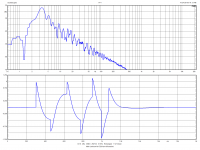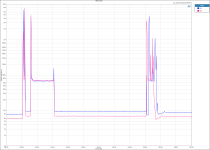Hello:
I have an issue with a new ML No. 532H that I will not send off for repair, thus I'm hoping to get some insight into fixing it myself or simply learning about it if it's a design error. I know that's a very weird opening statement.
Here's the deal. In the late 80's I had a No. 23 that forever changed my concept of amplifiers. Until that purchase I did not believe that an amplifier could make an audible difference in a sound system unless it was poorly designed or broken. Loudspeakers obviously have orders of magnitude greater distortion in any domain you'd care to consider, thus I figured that a properly operating amplifier couldn't begin to make an audible difference one way or the other.
Like so many other times in life, I was wrong. 🙂
Fast forward to a few months ago. I hear all these amazing things about the 532H and bite the bullet from a trustworthy shop that had an eBay presence on a used model. I get it for a reasonable price given the like-new condition it was advertised at and it shows up with one channel acting weird and running much hotter than the good channel. So the wonderful folks at that shop send me a brand new unit as a swap for an apology. Very nice.
I put the new amp on my bench and both channels are perfect. I place it in my sound system and once again, I simply cannot believe how much more open and real the music is in my sound system than previously. All good, right? Until I turn it off. When you turn the 532H on or off you hear a relay click, and when turning it on it's quiet. When turning it off there's a slight high frequency click when the relay closes and 32 seconds later there's a mid 3Hz sputter that is not dangerous to the loudspeakers, but it's stupid for an amp at this level.
So... it's obviously under warranty, but Harman, the current owners of the brand don't bother to maintain the product themselves - they give you a list of "trusted" repair shops to send it to. I've used one of those shops in the past and will never do it again. Personally, due to this "sell it and forget it" philosophy, I'd never buy Mark Levinson other than wildly discounted.
Here's an FFT and Scope view of the turn off noise:

Here's a zipped mono wave file of a 48kHz/16bit recording of same normalized to -1dBFS if you'd like to hear it:
View attachment No 523H Turn Off.zip
Is this just the capacitors draining? Surely there must be some way to avoid this noise. I'm a newbie with amps, but I won't be that way for long on this forum. 🙂
I have an issue with a new ML No. 532H that I will not send off for repair, thus I'm hoping to get some insight into fixing it myself or simply learning about it if it's a design error. I know that's a very weird opening statement.
Here's the deal. In the late 80's I had a No. 23 that forever changed my concept of amplifiers. Until that purchase I did not believe that an amplifier could make an audible difference in a sound system unless it was poorly designed or broken. Loudspeakers obviously have orders of magnitude greater distortion in any domain you'd care to consider, thus I figured that a properly operating amplifier couldn't begin to make an audible difference one way or the other.
Like so many other times in life, I was wrong. 🙂
Fast forward to a few months ago. I hear all these amazing things about the 532H and bite the bullet from a trustworthy shop that had an eBay presence on a used model. I get it for a reasonable price given the like-new condition it was advertised at and it shows up with one channel acting weird and running much hotter than the good channel. So the wonderful folks at that shop send me a brand new unit as a swap for an apology. Very nice.
I put the new amp on my bench and both channels are perfect. I place it in my sound system and once again, I simply cannot believe how much more open and real the music is in my sound system than previously. All good, right? Until I turn it off. When you turn the 532H on or off you hear a relay click, and when turning it on it's quiet. When turning it off there's a slight high frequency click when the relay closes and 32 seconds later there's a mid 3Hz sputter that is not dangerous to the loudspeakers, but it's stupid for an amp at this level.
So... it's obviously under warranty, but Harman, the current owners of the brand don't bother to maintain the product themselves - they give you a list of "trusted" repair shops to send it to. I've used one of those shops in the past and will never do it again. Personally, due to this "sell it and forget it" philosophy, I'd never buy Mark Levinson other than wildly discounted.
Here's an FFT and Scope view of the turn off noise:

Here's a zipped mono wave file of a 48kHz/16bit recording of same normalized to -1dBFS if you'd like to hear it:
View attachment No 523H Turn Off.zip
Is this just the capacitors draining? Surely there must be some way to avoid this noise. I'm a newbie with amps, but I won't be that way for long on this forum. 🙂
Last edited:
Any clue where said relay is sitting, circuit wise? If it's a protection relay at the output, it may suffer from welded contacts. If it is elsewhere, like in the power supply, what you're seeing may be normal. After all, the big 532 sans H boasts "no relays, capacitors, or inductors" in the signal path "to minimize forms of nonlinearity and maintain very low output impedance levels". Not sure what sort of protection circuitry these have, possibly just a crowbar job (effective if brutal).
Thanks so much for your thoughts on this and I apologize for taking so long to reply! It's obvious you have experience with ML amps. 🙂
I don't think there are any relays on the output, but another observation is that the noise is about 6dB less when the amp's inputs are switched to unbalanced. Thus the source of the noise may be from the input circuit. Same thing happens on both channels, though the right occurs about 30 seconds after going into standby and the left about 31 seconds after going into standby. I made the noise measurements with no cables connected to the amp other than the loudspeaker cables, BTW.
I've been back and forth with Harman's tech support and they finally raised the white flag and said they'd send me a replacement amp or repair my existing amp if I'd prefer. Thus I learn nothing - unless the replacement amp has the same symptoms - then it's probably normal behavior.
The emails were between me and a middle man that kept having to contact a mysterious 3rd party before replying back to me. Their official position, unsurprisingly, is that the amp should be silent when coming out of standby and going into standby. We'll see. I'll have them send me a replacement amp and report back with my findings.
If I can find some time I'll perform and post a full set of AP measurements including those performed by Stereophile in their review for comparison.
I don't think there are any relays on the output, but another observation is that the noise is about 6dB less when the amp's inputs are switched to unbalanced. Thus the source of the noise may be from the input circuit. Same thing happens on both channels, though the right occurs about 30 seconds after going into standby and the left about 31 seconds after going into standby. I made the noise measurements with no cables connected to the amp other than the loudspeaker cables, BTW.
I've been back and forth with Harman's tech support and they finally raised the white flag and said they'd send me a replacement amp or repair my existing amp if I'd prefer. Thus I learn nothing - unless the replacement amp has the same symptoms - then it's probably normal behavior.
The emails were between me and a middle man that kept having to contact a mysterious 3rd party before replying back to me. Their official position, unsurprisingly, is that the amp should be silent when coming out of standby and going into standby. We'll see. I'll have them send me a replacement amp and report back with my findings.
If I can find some time I'll perform and post a full set of AP measurements including those performed by Stereophile in their review for comparison.
Last edited:
...If it is elsewhere, like in the power supply, what you're seeing may be normal. After all, the big 532 sans H boasts "no relays, capacitors, or inductors" in the signal path "to minimize forms of nonlinearity and maintain very low output impedance levels"...
I completed a battery of measurements on the replacement 532H amp today and saw very similar results to the previous amp. DC offset and bias are closer between channels on the replacement amp, but IMO the previous amp was close enough to consider within spec.
The interesting conclusion here is that the slight turn-on and more than slight turn-off noise is normal and the representative that I dealt with and the folks he was speaking to didn't even know it - otherwise they'd never sent a replacement. It's also interesting that no review I've found on the Net has mentioned it.
The measurement below is a one minute RMS recording of the turn-on / turn-off noise using a 10 sample per second acquisition resolution into a 4Ω resistive load. I pressed the Stand By switch to turn the amp on at 5 seconds and pressed the Stand By switch a second time to turn it off at 15 seconds. Both those noise peaks are audibly subtle.
The power supply drain-down noise at 45 seconds is not so subtle, particularly at VLF (see 1st post) and the inspiration for this thread. Nevertheless I consider it acceptable given how wonderful this thing sounds in use. I told Samsung - Oops! - I mean Harman that if this was normal I was fine with it, but they maintained it was not and spent a pretty penny on two-way shipping to (unsuccessfully) prove it.

Last edited:
- Status
- Not open for further replies.